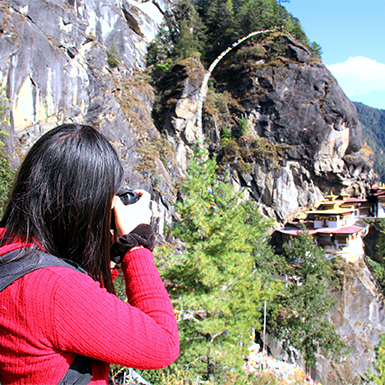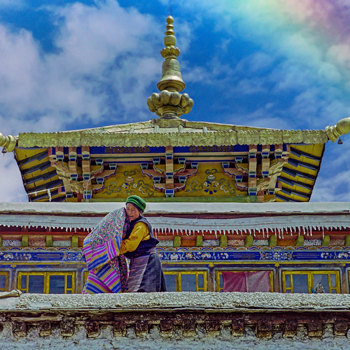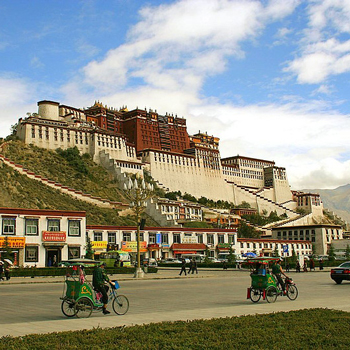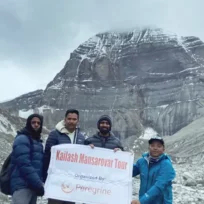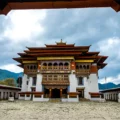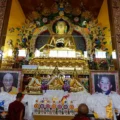Drepung Monastery is one of the “Great Three” Gelug University monasteries, towering over the Tibetan landscape near Lhasa in testimony to the enduring legacy of Gelugpa Buddhism, rich in history and architectural beauty, with a vibrant monastic community. Whether you’re a spiritual seeker or a history buff, Drepung Monks offers a unique and unforgettable experience.
Unveiling Drepung’s Grandeur
Drepung, meaning “Rice Heap” in Tibetan, is aptly named for its whitewashed buildings cascading down a hillside. Jamyang Choje Tashi Palden, whose mentor was Tsongkhapa, established Drepung Monastery in 1416. At its most dominant period, the place accommodated about ten thousand monks, thus becoming the biggest monastery globally. Drepung’s reputation for exceptional scholarship earned it the title “Nalanda of Tibet,” a reference to the famed Indian Buddhist University.

Drepung Monastery History
Drepung Monastery’s story stretches back centuries, intricately woven into the fabric of Tibetan Buddhism. Let’s delve into its fascinating past:
From Humble Beginnings to Grand Flourishing
The roots of Drepung go back to the spiritual dedication shown by Jamyang Chogyel Tashi Palden, a close disciple of Tsongkhapa, the revered founder of Gelugpa. Jamyang Chojey envisioned a center for learning and established the monastery with the patronage of the nobleman Langka Sangbu. “Drepung,” meaning “Rice Heap” in Tibetan, reflects the whitewashed buildings that gradually accumulated on the hillside, resembling a bountiful rice harvest.
A Beacon of Gelugpa Learning
Drepung’s reputation for exceptional scholarship blossomed rapidly. The monastery attracted many monks, eventually becoming the largest globally, with a peak population of 10,000. Its rigorous curriculum and emphasis on debate earned Drepung the esteemed title of “Nalanda of Tibet,” a tribute to the famed Indian Buddhist University. Within its walls, prominent Gelugpa scholars like Geshe Sharawa and Gyalwa Gendun Drub cultivated generations of learned monks who spread the Gelugpa teachings throughout Tibet.
A Seat of Power and Connection to the Dalai Lamas
Drepung’s influence extended beyond the realm of scholarship. In the 17th century, builders completed the Potala Palace, which today serves as a residence for the Dalai Lama. The early Dalai Lama’s 2nd, 3rd, and 4th remains are preserved within the same place, indicating how past events are interconnected. Drepung’s “Ganden Phodrang” functioned as the administrative center for the Dalai Lamas, further solidifying the monastery’s central role in Tibetan Buddhism.
A Marvel of Drepung Monastery Architecture
Drepung Monastery’s architectural grandeur reflects its historical significance. Let’s explore the fundamental structures and their symbolic meaning:
A Majestic Layout
Spread across a vast hillside, the Drepung Monastery layout resembles a mandala, a Buddhist symbol representing the universe. Buildings are clustered around the central Coqen Hall, radiating outwards harmoniously. Monks’ dormitories flank the main structures, while colleges dedicated to specific Gelugpa teachings occupy designated areas. This meticulous organization reflects the importance of order and hierarchy within the Gelugpa tradition.
Coqen Hall: The Heart of Drepung
The colossal Coqen Hall, also known as the “Great Hall of Dharma,” stands at the heart of the complex. This three-story structure houses a vast assembly hall where monks once gathered for debates and religious ceremonies. Intricate murals adorn the walls, depicting Buddhist deities and scenes from scripture. Sunlight streams through beautifully carved skylights, illuminating the grandeur of this sacred space.

Ganden Palace: A Legacy of the Dalai Lamas
The Ganden Palace, once the Dalai Lama’s residence before the Potala Palace’s construction, holds immense historical significance. Today, it houses the tombs of the 2nd, 3rd, and 4th Dalai Lama, serving as a pilgrimage site for devotees. The architectural style of the Ganden Palace mirrors that of the Potala Palace, offering a glimpse into the architectural lineage of Tibetan monastic structures.
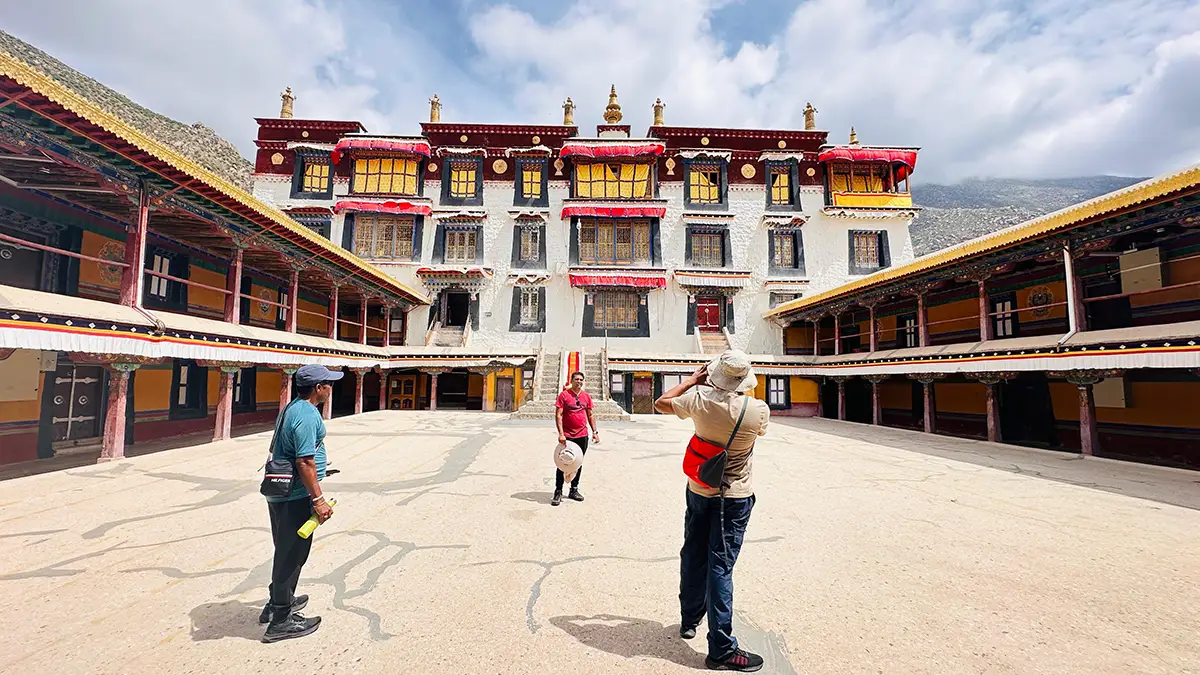
A Multitude of Colleges: Centers of Learning
Drepung Monastery comprised four leading colleges – Loseling, Gomang, Deyang, and Shagkor – each dedicated to specific Gelugpa teachings. These colleges housed classrooms, debating chambers, and libraries where monks spent years engrossed in philosophical and scriptural studies. The distinctive architecture of each college reflects its unique function within the monastery’s academic hierarchy.
Symbolic Elements: A Blend of Beauty and Meaning
Architecture is not merely functional; it embodies deep symbolism. The whitewashed walls represent purity, while the red roofs signify the power of Buddhist teachings. Prayer flags fluttering in the wind carry well wishes and blessings on the breeze. The intricate rooflines and ornately carved doorways showcase the skill of Tibetan artisans and pay homage to the beauty of the natural world.

Religious Significance and Practices at Drepung Monastery
This isn’t just an architectural marvel; it’s a vibrant center of Gelugpa learning and practice. Here, we’ll explore the educational system, daily routines, and unique practices that set Drepung apart.
A Center of Gelugpa Learning
The Gelug tradition, known for its emphasis on logic and debate, finds its heart at Drepung. For centuries, the monastery has functioned as a prestigious Gelugpa university, training generations of monks in:
- Scriptures: Monks meticulously study foundational Buddhist texts, including the Kangyur (translated teachings of the Buddha) and the Tengyur (commentaries by scholars).
- Philosophy: Dialectical debates are a cornerstone of Gelugpa education. Monks sharpen their reasoning skills by challenging each other’s interpretations of Buddhist doctrines.
- Rituals: Properly performing elaborate pujas (ritual offerings) and ceremonies is another crucial aspect of monastic training.
Daily Life at Drepung
The lives of Drepung Monastery revolve around a structured schedule that fosters spiritual development:
- Early Mornings: The day begins with group prayers and chanting, followed by individual meditation sessions.
- Studies and Debates: We dedicate afternoons to rigorous academic pursuits. Monks attend lectures or participate in lively debates, honing their understanding of Buddhist philosophy.
- Evening Practices: The day often concludes with additional prayers, communal activities, and personal study.

Unique Practices of Drepung
Drepung boasts some practices not found in other Tibetan Festivals:
- Monastic Colleges: The monastery divides its colleges into four: Loseling, Gomang, Deyang, and Sera, with each college focusing on specific aspects of Gelugpa teachings.
- Monlam Festival: Held annually during the Tibetan New Year, the Monlam Festival features weeks of prayer ceremonies and public teachings presided over by the Dalai Lama (when in Tibet).
Witnessing the Spectacle of the Shoton Festival
The Shoton Festival, or the “Yogurt Festival,” is essential to Tibetans. Marking the end of the monastic retreat period, it’s a time for rejoicing, feasting, and cultural performances. The festival culminates in a spectacular ceremony held at Drepung Monastery, drawing in pilgrims and tourists from around the globe.
The Unveiling of a Giant Thangka: A Breathtaking Spectacle
The centerpiece of the Drepung Monastery Festival, the Shoton Festival, is the awe-inspiring unveiling of a giant thangka by the Drepung Monks. This thangka, a silk tapestry depicting a revered Buddhist deity, can measure up to several meters tall and wide. On the designated day, a procession of monks carefully carries the thangka from the Coqen Hall to a specially constructed platform overlooking the monastery grounds.

A Ceremony Steeped in Tradition
As the first rays of dawn illuminate the landscape, anticipation builds among the crowd. The ceremony begins with the chanting of prayers and the resonating sounds of traditional Tibetan instruments. Slowly, with the utmost care, the monks unfold the massive thangka. This grand unveiling powerfully represents faith and bestows blessings upon the gathered masses.
A Moment of Shared Celebration
Pilgrims raise white ceremonial scarves (called katas) in offering as the thangka reaches its full display. Seeing the vibrant thangka against the backdrop of the majestic Himalayas creates a truly unforgettable experience. The atmosphere is shared joy, spiritual connection, and cultural reverence.
Beyond the Thangka: A Festival of Entertainment
The Drepung Monastery Festival, known as the Shoton Festival, extends beyond the thangka ceremony. Visitors can witness captivating performances of Tibetan opera, energetic folk dances, and traditional music. Food stalls offering delicious Tibetan treats, including yogurt drinks, line the festival grounds. The vibrant atmosphere provides a glimpse into Tibetan culture and a chance to mingle with locals celebrating this joyous occasion.
Planning Your Visit to Drepung Monastery
The majestic Drepung Monks beckon travelers seeking cultural immersion and spiritual connection. Here’s a comprehensive guide to planning your visit, ensuring a respectful and enriching experience.
Best Time to Visit
Drepung Monastery welcomes visitors year-round. However, the following times offer distinct advantages:
- Spring (April-May): Pleasant weather with blooming wildflowers.
- Shoton Festival (July/August): Witness the awe-inspiring giant thangka unveiling (dates vary).
- Autumn (September-October): Enjoy comfortable temperatures and vibrant fall foliage.

Important Considerations
- Permits: Tibet Travel permits are mandatory for foreigners visiting Tibet. Secure them well in advance through a reputable travel agency like Peregrine Treks and Tours.
- Altitude: Lhasa sits at a high altitude (3,656 meters). Allow ample time for acclimatization to avoid altitude sickness.
Getting There
Drepung Monastery lies roughly 5 kilometers west of Lhasa city center. Several options are available:
- Taxi: The most convenient option, offering door-to-door service.
- Bus: A budget-friendly option with regular departures from Lhasa.
- Organized Tour: Many Drepung Monastery Tours include transportation, a guide, and visits to see the Drepung Monks.
Respectful Visitation
Drepung Monastery remains an active place of worship. Here are some guidelines for respectful visitation:
- Dress modestly: Cover shoulders and knees.
- Quiet behavior: Maintain silence in prayer halls and refrain from using flash photography.
- Seek permission: Ask before photographing monks or religious objects.
- Offer a donation: A small donation to the monastery is a thoughtful gesture.
Exploring Drepung
Drepung Monastery is vast. Consider hiring a guide to navigate the labyrinthine corridors and uncover hidden gems. Here are some highlights not to miss:
- The Ganden Palace: Former residence of the Dalai Lamas.
- The Main Assembly Hall: A colossal structure with impressive Tibetan architecture.
- Monastic Colleges: Explore the unique characteristics of each college.
- Drepung Kora: Go on a scenic walking path around the monastery for panoramic views.
A Cornerstone of Tibetan Culture and Community
Drepung Monastery’s influence extends far beyond its monastery walls. This revered institution plays a central role in shaping Tibetan culture, fostering a strong sense of community, and contributing to the regional economy.
A Pillar of Tibetan Culture:
Drepung Monks have been a wellspring of Tibetan culture for centuries. Monks serve as custodians of ancient traditions, preserving knowledge of Buddhist scriptures, philosophy, and artistic practices. The intricate art forms showcased within the monastery, from intricate murals to sculpted mandalas, reflect the rich artistic heritage nurtured by Drepung. The vibrant ceremonies held throughout the year, like the Shoton Festival, draw in local communities, keeping traditions alive and fostering cultural identity.
A Thriving Community Hub:
Drepung Monks serve as a social and spiritual hub for the surrounding community. Residents visit the monastery to pray, seek spiritual guidance, or participate in religious ceremonies. Monks from Drepung often travel to nearby villages to lead teachings and offer blessings. This ongoing interaction strengthens the bonds between the monastery and the local population.
Economic Impact:
Drepung Monastery is a significant contributor to the Tibetan economy. Tourism plays a major role, with visitors worldwide drawn to the monastery’s architectural splendor and spiritual significance. Pilgrims seeking blessings and religious merit contribute to the local economy through lodging and other necessities. Additionally, the sale of traditional handicrafts produced by monks within the monastery provides a source of income.
Reaching Beyond the Monastery Walls:
The Drepung Monks community extends its positive influence beyond its immediate surroundings. Monks from Drepung are actively involved in social welfare initiatives, offering education and healthcare services to underprivileged communities. The monastery also plays a role in environmental conservation, promoting sustainable practices and fostering a connection with the natural world.
A Legacy of Service and Compassion
Drepung Monastery’s impact on Tibetan culture and society is undeniable. By serving as a center for learning, preserving traditions, and fostering a sense of community, the monks ensure the continuation of a rich cultural heritage. The monastery’s ongoing efforts to improve the lives of those in need further solidify its role as a cornerstone of Tibetan compassion and social responsibility.
Safeguarding a Tibetan Legacy
Drepung Monastery is a testament to centuries of Tibetan culture and spiritual practice. However, safeguarding this architectural and spiritual heritage requires ongoing efforts. Let’s explore the current preservation initiatives and the challenges they face:
Safeguarding the Physical Monastery:
- Restoration Projects: In recent years, Chinese authorities have undertaken restoration projects to preserve the structural integrity of the monastery, recognizing its importance. These projects focus on repairing damaged buildings, reinforcing aging structures, and addressing water damage.
- Monastery Management: The Drepung Monastery community is crucial in its upkeep. Monks participate in cleaning and maintaining the buildings, ensuring the long-term preservation of the site.
Challenges in Conservation:
- Balancing Modernization with Tradition: It can be challenging to balance necessary repairs and preserve the monastery’s historical character. Modernization efforts should complement the existing architectural style to maintain the site’s authenticity.
- Environmental Factors: The harsh Tibetan climate, with its strong winds and extreme temperatures, constantly threatens the monastery’s structures. Effective measures to protect the buildings from these elements are crucial for long-term preservation.
- Funding and Resources: Securing sufficient funding for ongoing restoration projects and maintenance remains challenging. Donations from patrons and support from cultural organizations are vital in ensuring the monastery’s continued well-being.
Preserving the Spiritual Legacy:
- Lineage and Transmission: The Drepung monastic community is vital in transmitting the Gelugpa tradition to future generations. Ensuring the continuation of this lineage through the proper training and education of young monks is essential for preserving the spiritual heritage.
- Documentation and Scholarship: Efforts to document the monastery’s history, rituals, and teachings through written records and oral traditions are crucial for safeguarding the intangible aspects of Drepung’s legacy.
Conclusion
Drepung Monastery isn’t just a magnificent architectural marvel; it’s a vibrant tapestry woven from centuries of Tibetan history, culture, and spiritual practice. Here’s a quick recap of what makes this monastery so special:
A Journey through Time:
Drepung’s rich history, from its humble beginnings as a disciple’s vision to its role as a seat of power for the Dalai Lamas, offers a fascinating glimpse into the evolution of Tibetan Buddhism. The meticulously preserved architecture reflects the influence of the Gelugpa philosophy and Tibetan artisans’ artistry.
A Center of Spiritual Growth:
Beyond its physical grandeur, Drepung Monastery remains a vibrant center of monastic life. The monks’ dedication to study, debate, and meditation fosters a profound sense of peace and tranquility within the monastery walls. Visitors can witness unique rituals and ceremonies, gaining a deeper appreciation for the Gelugpa tradition.
A Cultural Heartbeat:
Drepung Monastery’s impact extends far beyond its walls. It serves as a cultural hub for the surrounding community, preserving ancient traditions and fostering a strong sense of identity. The annual Shoton Festival’s vibrant display of the giant thangka powerfully illustrates this cultural connection.
A Legacy for the Future:
The ongoing preservation efforts, both physical and spiritual, ensure that the Drepung Monks’ legacy continues to inspire future generations. Drepung Monks offers an unforgettable experience, no matter your interest in history, spirituality, or multiculturalism.
Planning Your Drepung Monks Visit:
Remember, to fully appreciate Drepung Monastery, plan your trip accordingly. Knowing the research permit requirements, when best to visit, and how to behave inside the monastery gardens is essential. You may consider guided tours, as these enable you to understand more about this great place’s history, architecture, and spiritual importance.

